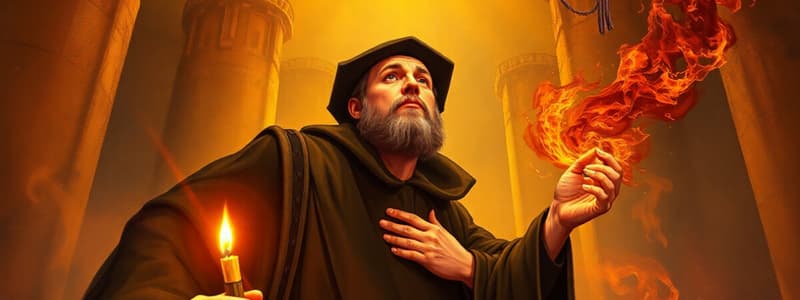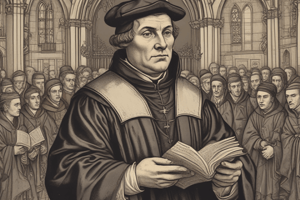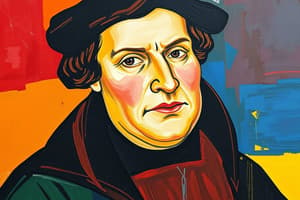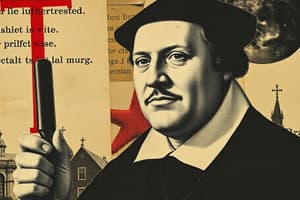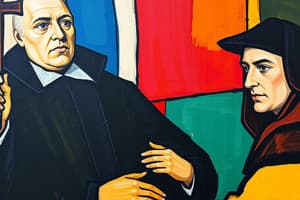Podcast
Questions and Answers
What was a significant theological teaching of Luther regarding salvation?
What was a significant theological teaching of Luther regarding salvation?
- Salvation is earned through good deeds.
- Salvation can only be attained through a priest.
- Salvation is a free gift of God’s grace. (correct)
- Salvation requires regular donations to the Church.
What major change did the Protestant Reformation bring about in the religious structure?
What major change did the Protestant Reformation bring about in the religious structure?
- Formation of numerous Christian denominations. (correct)
- Increased central authority of the pope.
- Decline in literacy among the population.
- Reestablishment of priestly intervention for forgiveness of sins.
What was the result of the Edict of Worms for Luther?
What was the result of the Edict of Worms for Luther?
- He was appointed as the new pope.
- He was rewarded for his teachings.
- He was invited to lead the Catholic Church.
- He was excommunicated and declared an outlaw. (correct)
Which of the following was NOT an effect of the Protestant Reformation?
Which of the following was NOT an effect of the Protestant Reformation?
What were followers of Luther commonly referred to as?
What were followers of Luther commonly referred to as?
How did Luther's teachings influence the role of the Bible?
How did Luther's teachings influence the role of the Bible?
What was a consequence of the Reformation regarding colonial territories?
What was a consequence of the Reformation regarding colonial territories?
Which event was directly linked to the rise of Henry VIII's reign?
Which event was directly linked to the rise of Henry VIII's reign?
Who became Lord Protector after Lord Somerset lost support due to financial problems?
Who became Lord Protector after Lord Somerset lost support due to financial problems?
What significant change regarding church services was implemented during Edward VI's reign?
What significant change regarding church services was implemented during Edward VI's reign?
Which concept became significant in belief during the Protestant transformation under Edward VI?
Which concept became significant in belief during the Protestant transformation under Edward VI?
What evidence suggests social unrest during Edward VI's reign?
What evidence suggests social unrest during Edward VI's reign?
Which individual was instrumental in improving England's economic conditions during Edward VI's reign?
Which individual was instrumental in improving England's economic conditions during Edward VI's reign?
What significant transformation occurred in the Church of England during Edward VI's reign?
What significant transformation occurred in the Church of England during Edward VI's reign?
Which document was introduced to standardize prayers across the Church of England?
Which document was introduced to standardize prayers across the Church of England?
What uncertainty exists concerning the beliefs of the laity by Edward VI's death?
What uncertainty exists concerning the beliefs of the laity by Edward VI's death?
What was mandated by the Act of Uniformity regarding attendance at religious services?
What was mandated by the Act of Uniformity regarding attendance at religious services?
How did Henry VIII increase the power of Parliament in the 1530s?
How did Henry VIII increase the power of Parliament in the 1530s?
Who were the members of the House of Commons primarily composed of during the 16th century?
Who were the members of the House of Commons primarily composed of during the 16th century?
What was Elizabeth I's approach to working with Parliament?
What was Elizabeth I's approach to working with Parliament?
What economic trend began to emerge in England during the latter half of the century?
What economic trend began to emerge in England during the latter half of the century?
What role did privateers like Hawkins and Drake play in Elizabethan England?
What role did privateers like Hawkins and Drake play in Elizabethan England?
Which regions did England focus on for colonization during the late 16th century?
Which regions did England focus on for colonization during the late 16th century?
What led to the rise of successful merchant adventurers in England?
What led to the rise of successful merchant adventurers in England?
What significant action did Mary I take to maintain her power after ascending the throne?
What significant action did Mary I take to maintain her power after ascending the throne?
What was a key factor in the relatively smooth transition from Edward VI to Mary I's reign?
What was a key factor in the relatively smooth transition from Edward VI to Mary I's reign?
What was one reason for the failure of Mary's attempt to restore Catholicism in England?
What was one reason for the failure of Mary's attempt to restore Catholicism in England?
How did Mary I's authority over the Church differ from that of her father, Henry VIII?
How did Mary I's authority over the Church differ from that of her father, Henry VIII?
What was the political significance of Mary I's marriage to Philip II of Spain?
What was the political significance of Mary I's marriage to Philip II of Spain?
What challenge did Mary's regime face regarding its relationship with the papacy?
What challenge did Mary's regime face regarding its relationship with the papacy?
What was established as part of Elizabeth I's Religious Settlement in 1559?
What was established as part of Elizabeth I's Religious Settlement in 1559?
Which of the following correctly characterizes the Edwardian Reformation?
Which of the following correctly characterizes the Edwardian Reformation?
What was a primary consequence of the Petition of Right in 1628?
What was a primary consequence of the Petition of Right in 1628?
Which event directly triggered the First Bishops' War in 1639?
Which event directly triggered the First Bishops' War in 1639?
What was a critical outcome of the 'Short Parliament' summoned by Charles I?
What was a critical outcome of the 'Short Parliament' summoned by Charles I?
What was a significant criticism directed at Charles I during his reign?
What was a significant criticism directed at Charles I during his reign?
Which battle marked a significant early confrontation in the English Civil War?
Which battle marked a significant early confrontation in the English Civil War?
Which group began to dominate Parliament during the Long Parliament sessions?
Which group began to dominate Parliament during the Long Parliament sessions?
What was a major factor that led to the execution of King Charles I in 1649?
What was a major factor that led to the execution of King Charles I in 1649?
How did Charles I's actions toward Parliament during his reign reflect his governance style?
How did Charles I's actions toward Parliament during his reign reflect his governance style?
What was the primary role of Oliver Cromwell during the Commonwealth period?
What was the primary role of Oliver Cromwell during the Commonwealth period?
Which event marked the end of Cromwell's attempt to unify England, Scotland, and Ireland?
Which event marked the end of Cromwell's attempt to unify England, Scotland, and Ireland?
What was the Navigation Act of 1651 designed to achieve?
What was the Navigation Act of 1651 designed to achieve?
What major change did Blake implement during the Commonwealth regarding the navy?
What major change did Blake implement during the Commonwealth regarding the navy?
What was a common sentiment towards Cromwell's rule among the populace?
What was a common sentiment towards Cromwell's rule among the populace?
What conflict did England engage in between 1652 and 1674?
What conflict did England engage in between 1652 and 1674?
Which territory was NOT part of the English Empire in North America during Cromwell's time?
Which territory was NOT part of the English Empire in North America during Cromwell's time?
What was one significant outcome of Scotland acknowledging Charles II as king?
What was one significant outcome of Scotland acknowledging Charles II as king?
Flashcards
Luther's Salvation View
Luther's Salvation View
Luther believed salvation comes from God's grace through faith in Jesus, not good deeds.
Luther's Bible Authority
Luther's Bible Authority
Luther emphasized the Bible as the sole source of divine knowledge, opposing priestly authority.
Edict of Worms
Edict of Worms
A 1521 decree declaring Luther an outlaw and banning his writings.
Lutherans
Lutherans
Signup and view all the flashcards
Protestant Reformation
Protestant Reformation
Signup and view all the flashcards
Effects of Reformation (Literacy)
Effects of Reformation (Literacy)
Signup and view all the flashcards
Effects of Reformation (Denominations)
Effects of Reformation (Denominations)
Signup and view all the flashcards
Effects of Reformation (Church Power)
Effects of Reformation (Church Power)
Signup and view all the flashcards
Edward VI's Reign
Edward VI's Reign
Signup and view all the flashcards
Edward VI's Regency
Edward VI's Regency
Signup and view all the flashcards
Privy Council
Privy Council
Signup and view all the flashcards
Lord Protector
Lord Protector
Signup and view all the flashcards
Protestant Church Establishment
Protestant Church Establishment
Signup and view all the flashcards
Common Prayer Book
Common Prayer Book
Signup and view all the flashcards
English Replaced Latin
English Replaced Latin
Signup and view all the flashcards
Thomas Cranmer
Thomas Cranmer
Signup and view all the flashcards
Mary I's Reign (1553-1558)
Mary I's Reign (1553-1558)
Signup and view all the flashcards
Edwardian Reformation
Edwardian Reformation
Signup and view all the flashcards
Mary's succession Crisis
Mary's succession Crisis
Signup and view all the flashcards
Mary I's marital choice
Mary I's marital choice
Signup and view all the flashcards
Religious settlement of 1559 (Elizabeth I)
Religious settlement of 1559 (Elizabeth I)
Signup and view all the flashcards
Smooth political transition under Mary
Smooth political transition under Mary
Signup and view all the flashcards
Parliamentary legislation and religious authority
Parliamentary legislation and religious authority
Signup and view all the flashcards
Restoration of relations with Rome
Restoration of relations with Rome
Signup and view all the flashcards
Act of Uniformity
Act of Uniformity
Signup and view all the flashcards
Puritans
Puritans
Signup and view all the flashcards
Parliament's Growing Power
Parliament's Growing Power
Signup and view all the flashcards
House of Commons: Gentry & Burgesses
House of Commons: Gentry & Burgesses
Signup and view all the flashcards
Elizabeth I and Parliament
Elizabeth I and Parliament
Signup and view all the flashcards
The Rise of English Trade
The Rise of English Trade
Signup and view all the flashcards
English Piracy & Spanish Treasure Ships
English Piracy & Spanish Treasure Ships
Signup and view all the flashcards
English Colonial Expansion
English Colonial Expansion
Signup and view all the flashcards
Charles I's 'Useless Parliament'
Charles I's 'Useless Parliament'
Signup and view all the flashcards
Petition of Right (1628)
Petition of Right (1628)
Signup and view all the flashcards
Charles I's 'Sole Rule'
Charles I's 'Sole Rule'
Signup and view all the flashcards
Scottish Bishops Wars
Scottish Bishops Wars
Signup and view all the flashcards
Scottish National Covenant
Scottish National Covenant
Signup and view all the flashcards
Long Parliament (1640)
Long Parliament (1640)
Signup and view all the flashcards
Grand Remonstrance (1641)
Grand Remonstrance (1641)
Signup and view all the flashcards
Battle of Naseby (1645)
Battle of Naseby (1645)
Signup and view all the flashcards
Cromwell's Ireland Campaign
Cromwell's Ireland Campaign
Signup and view all the flashcards
Navigation Act (1651)
Navigation Act (1651)
Signup and view all the flashcards
Commonwealth's Isolation
Commonwealth's Isolation
Signup and view all the flashcards
Dutch East India Company
Dutch East India Company
Signup and view all the flashcards
Anglo-Dutch Wars
Anglo-Dutch Wars
Signup and view all the flashcards
Commonwealth's Troubles
Commonwealth's Troubles
Signup and view all the flashcards
Restoration of Monarchy
Restoration of Monarchy
Signup and view all the flashcards
Richard Cromwell's Succession
Richard Cromwell's Succession
Signup and view all the flashcards
Study Notes
Protestant Reformation
- Growing concerns about the Catholic Church's power and influence led to challenges to its doctrine.
- Questionable practices like simony, indulgences, excessive wealth, and clerical violations of biblical rules were issues.
- Initial challenges aimed to reform the Catholic Church, but ultimately created a schism in Europe.
Context of Reformation
- Previous attempts at church reform in Europe (e.g., Jan Huss, John Wycliffe) had occurred.
- These reformers were executed for challenging church doctrine.
- Martin Luther is a key figure in the Reformation.
Motivating Factors of the Reformation
- A Catholic Monk (Luther) believed corrupt teachings and practices warranted reform.
- While indulgences were central, other practices, such as clerical immorality, simony, nepotism, and pluralism contributed to the diminishing respect for the Catholic Church.
The Selling of Indulgences
- The Catholic Church sold indulgences, which were papal pardons for reducing time spent in purgatory.
- The money raised was used to build St. Peter's Basilica in Rome, primarily during the early 1500s, authorized by Pope Leo X.
- The selling affected different social groups differently, with wealth flowing from some to others.
Luther's Teachings and Excommunication
- Luther taught salvation is a gift from God's grace, not earned by good deeds.
- He challenged papal authority, emphasizing the Bible as the sole source of truth. — he believed all Christians to be a 'holy priesthood'
- The Emperor Charles V excommunicated Luther and declared him a heretic.
Effects of the Reformation
- Increased literacy and independent thinking
- Numerous denominations of Christianity
- Wars between differing Christian denominations
- A lessening of Church influence in state affairs
- Colonization affected by religious beliefs
Henry VIII's Reign as King
- The War of the Roses led to the Tudor Dynasty gaining power in England.
- Henry VIII was King of England from 1509 until 1547.
- His desire to have a male heir to the throne was a factor in his reforms.
Religious and Political Aspects of Henry VIII's Reign
- Henry VIII's marriage to Catherine of Aragon was annulled, and he married Anne Boleyn.
- Henry sought an annulment due to not having a son, against the advice of Cardinal Wolsey.
- This led to the Act in Restraint of Appeals, making England a sovereign state separate from the Catholic Church.
- An Act of Supremacy made Henry the Supreme Head of the Church in England in 1534.
Henry VIII and the Reformation
- Henry remained a Catholic, and did not wholly embrace the reformation's concepts, though his breakaway from the church resulted in many changes.
- He controversially was given the title "Defender of the Faith" by Pope Leo X.
Edward VI's Reign
- Edward VI became king as a child, and the Protestant Church became more prominent during his time, through leadership of a regency Privy Council.
- The concept of "faith alone" became a key element of belief during this period, with icons removed from church services.
Mary I Reign
- Succession crises emerged with Mary I's succession.
- Despite fears of religious conflict, the transition occurred relatively smoothly.
- Mary I sought to return England to the Catholic faith.
Elizabeth I's Reign
- Elizabeth I restored a balance between Protestantism and Catholicism, using a combination of religious freedom and royal control.
- The Act of Uniformity determined attendance at Anglican Mass, using the Book of Common Prayer, which kept the crucifix in church services and structures.
The Stuart Monarchs: James I and Charles I
- Parliament gained power during the reign of the Stuart monarchs.
- The Stuart monarchs were embroiled in conflict between their belief in the divine right of kings and the assertion of Parliament's rights.
- Religious divisions increased as Puritan beliefs grew. Many in Parliament saw the Stuarts' religious policies as an inappropriate intrusion into matters of policy.
The English Civil War
- The English Civil War resulted in the eventual fall of the Monarchy and the establishment of a Commonwealth.
The Commonwealth, Republic, and Protectorate
- The execution of Charles I led to a republic in England.
- Oliver Cromwell became the Lord Protector, establishing a military dictatorship with support and dissent.
The Restoration
- The Restoration of the monarchy with Charles II in 1660 marked a period of reversal for England.
- The Glorious Revolution, initiated by William and Mary of Orange, ensured the Parliament had a greater role in government.
The Glorious Revolution
- Parliament's role grew in power.
- A balance of power between the king and the Parliament, as enshrined in the Bill of Rights, was established.
Studying That Suits You
Use AI to generate personalized quizzes and flashcards to suit your learning preferences.
